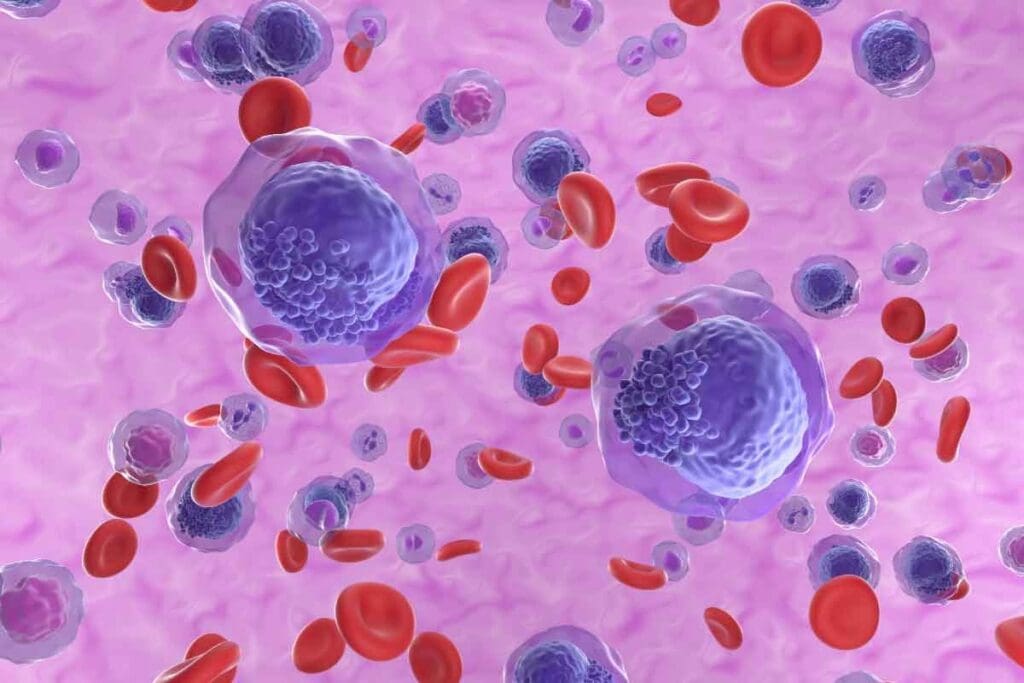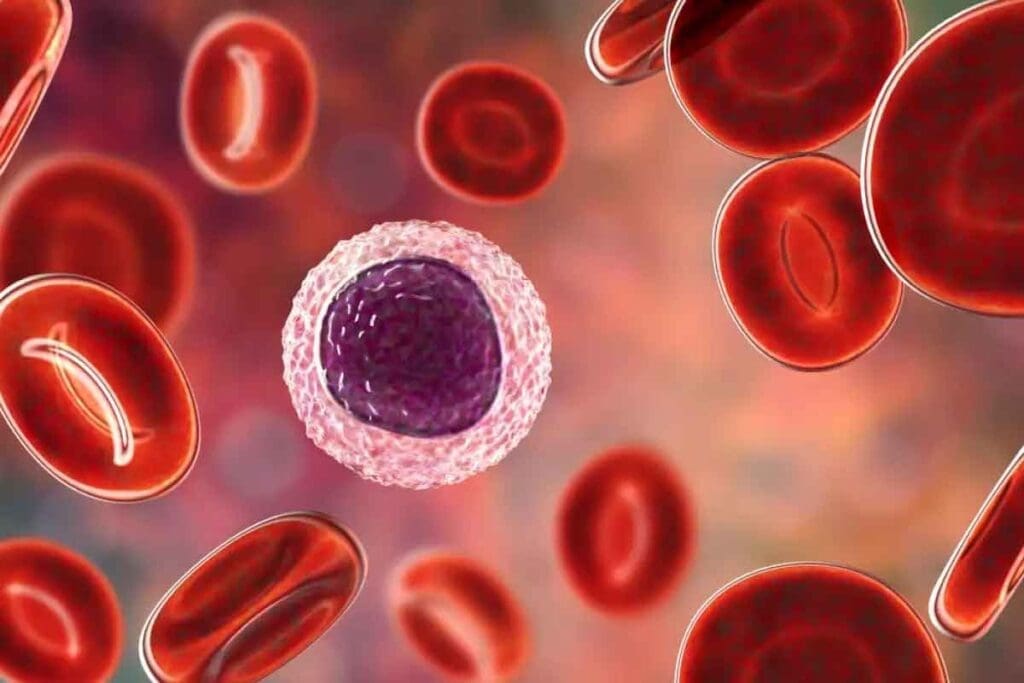Last Updated on November 20, 2025 by Ugurkan Demir

Acute Lymphoblastic Leukemia (ALL) is a fast-growing blood cancer that starts in the bone marrow. It mainly hits kids but can also affect adults. Knowing the risks and symptoms of ALL is key to managing it well.
At Liv Hospital, we understand how important quick action and tailored care are for ALL patients. Our teams are trusted worldwide for their patient-focused approach. They have the latest knowledge to tackle ALL’s complex challenges.
We’re dedicated to giving each patient the care they need. By looking into ALL’s major complications, we want to help patients and their families. This way, they can better handle this tough condition.

To understand Acute Lymphoblastic Leukemia (ALL) complications, we must first know how the disease works. ALL is a cancer that affects the blood and bone marrow. It causes the growth of abnormal, immature lymphocytes without control.
ALL is a condition where the bone marrow makes too many immature lymphocytes. These cells can’t work right. This makes less normal blood cells, like red and white blood cells, and platelets.
The growth of bad lymphocytes in the bone marrow messes up blood cell making. This can cause anemia, infections, and bleeding problems. It’s because there aren’t enough red blood cells, white blood cells, and platelets.
This can lead to big problems. The table below shows how ALL affects different blood cells:
| Blood Cell Type | Normal Function | Effect of ALL |
| Red Blood Cells | Carry oxygen throughout the body | Anemia, fatigue, weakness |
| White Blood Cells | Fight infections | Increased susceptibility to infections |
| Platelets | Essential for blood clotting | Bleeding disorders, bruising |
Several things can make complications more likely in ALL patients. These include age, genetic issues, and how well the first treatment works.
Knowing these risk factors helps manage the disease better. This can lower the chance of complications. We’ll look at these points more in the next sections.

Acute Lymphoblastic Leukemia (ALL) can lead to serious complications. These can greatly affect how well a patient does. It’s important to know how the disease’s growth impacts these issues. Also, how they vary between adults and kids.
People with ALL face several major issues. These include anemia, infections, bleeding disorders, and central nervous system involvement. These problems can come from the disease itself or from treatment.
“The management of ALL requires a complete approach to lessen these issues and better patient results,” studies say. It’s key to have good management plans to lower complication risks.
As ALL gets worse, the risk of complications grows. Patients become more likely to get infections and bleeding problems. This is because the disease stops normal blood cell making.
While ALL complications are similar, there are big differences between adults and kids. Adults often face more severe problems because of other health issues and the disease’s aggressive nature in older people.
Children with ALL might have a better chance of getting better and fewer long-term problems. This is because they are generally healthier and respond better to treatment. But, both groups need special treatment plans to meet their unique needs and lower complication risks.
Knowing these differences helps doctors create better plans to manage ALL complications. This can lead to better results for patients.
Anemia is a common problem for people with Acute Lymphoblastic Leukemia. It greatly affects their life quality. It’s important to know how it works, its signs, and how to treat it to manage ALL well.
Anemia in ALL patients happens when leukemia cells fill the bone marrow. This blocks normal blood cell making. It leads to fewer red blood cells, causing anemia. A doctor said,
“The bone marrow’s inability to produce enough red blood cells due to leukemia cell infiltration is a big challenge in managing ALL.”
This problem affects not just red blood cells but also the patient’s health and well-being.
Severe anemia symptoms are very hard to deal with. Patients often feel fatigue, weakness, and shortness of breath. These symptoms make everyday tasks hard. A patient said,
“The fatigue was overwhelming; it felt like I was running a marathon every day.”
Doctors need to watch for these signs to help patients quickly.
Dealing with anemia in ALL patients often means red blood cell transfusions. These help carry oxygen better and ease symptoms. The choice to transfuse depends on how bad the anemia is and the patient’s health. Erythropoiesis-stimulating agents might also be used to help make more red blood cells. Managing anemia well is key to better patient outcomes and life quality.
ALL not only affects the production of healthy blood cells but also severely impairs the immune system, increasing the risk of infections. This vulnerability is mainly due to neutropenia. Neutropenia is a condition where there are not enough neutrophils, which are key white blood cells that fight infections.
The immune system of patients with ALL is compromised in several ways. The disease itself infiltrates the bone marrow, where immune cells are produced. This reduces the production of effective immune cells. Treatments for ALL, such as chemotherapy, also suppress the bone marrow’s ability to produce these vital cells. As a result, patients become highly susceptible to infections.
We will discuss the mechanisms behind this immune compromise and its clinical implications. Understanding these factors is key to managing the risk of infections in ALL patients.
Patients with ALL are at risk of infections from a wide range of pathogens, including bacteria, viruses, and fungi. Common infection sites include the respiratory tract, gastrointestinal tract, and skin. Identifying these pathogens and understanding their typical infection sites can help in diagnosing and treating infections promptly.
| Pathogen Type | Common Pathogens | Typical Infection Sites |
| Bacteria | Gram-positive cocci (e.g., Staphylococcus aureus), Gram-negative rods (e.g., Escherichia coli) | Respiratory tract, bloodstream, skin |
| Viruses | Respiratory viruses (e.g., influenza, RSV), Herpesviruses (e.g., CMV, HSV) | Respiratory tract, mucous membranes |
| Fungi | Candida species, Aspergillus species | Lungs, bloodstream, mucous membranes |
Recognizing the warning signs of serious infections is critical for timely intervention. Symptoms may include fever, chills, cough, shortness of breath, and localized pain or swelling. In severe cases, infections can lead to sepsis, a life-threatening condition that requires immediate medical attention.
We must emphasize the importance of vigilance and prompt reporting of any suspicious symptoms to healthcare providers. Early detection and treatment of infections can significantly improve outcomes for ALL patients.
Acute Lymphoblastic Leukemia (ALL) often causes bleeding problems. This is because of thrombocytopenia, a low platelet count. We’ll look at how ALL affects platelets, the symptoms of bleeding, and how to handle emergencies.
In ALL, leukemia cells in the bone marrow stop normal platelet production. This leads to thrombocytopenia, raising the risk of bleeding. Platelet dysfunction can also happen, making platelets not work right.
It’s important to understand how platelet dysfunction works. The bone marrow can’t make enough or functional platelets. This makes it hard for the body to stop bleeding.
Bleeding problems in ALL patients show up in different ways. These include:
Spotting these symptoms early is key for quick action.
Severe bleeding needs quick action to keep the patient stable. The steps for emergency management include:
| Management Strategy | Description |
| Platelet Transfusion | Platelet transfusions to boost platelet count and clotting. |
| Supportive Care | Supportive care, like watching vital signs and managing symptoms. |
| Addressing Underlying Cause | Treatment for the bleeding cause, like adjusting treatment or treating infections. |
Handling bleeding complications well needs a team effort. Hematologists, oncologists, and others work together. Knowing the risks and symptoms of bleeding in ALL helps us care for patients better.
Central nervous system involvement is a serious problem in Acute Lymphoblastic Leukemia (ALL). It needs quick diagnosis and treatment. The brain and spinal cord can get filled with leukemia cells, causing many symptoms.
How leukemia cells get into the CNS is complex. They can move through the blood and get past the blood-brain barrier. This barrier keeps harmful stuff out of the brain and spinal cord. Once inside, these cells can grow and harm the brain tissue.
Some genetic changes in leukemia cells and poor treatment penetration into the CNS raise the risk. Knowing how this happens helps us find better ways to prevent and treat it.
CNS involvement in ALL can cause many symptoms. Patients might have headaches, seizures, and problems with nerves. They can also have trouble with memory and focus.
“The presence of neurological symptoms in a patient with ALL should prompt immediate evaluation for CNS involvement.”
Spotting these symptoms early is key to treating them quickly.
Diagnosing CNS involvement in ALL involves several steps. Lumbar puncture, or spinal tap, is a key test to check for leukemia cells in the CSF.
Imaging like MRI can show brain and spinal cord problems. We use these tests to confirm CNS involvement and plan treatment.
Understanding how it happens, recognizing symptoms, and using the right tests help us manage CNS involvement in ALL. This improves patient outcomes.
Organ infiltration is a big worry in ALL, leading to many systemic problems. When leukemia cells spread to different organs, patients face various symptoms. These can really affect their life quality and how well they might do with the disease.
Hepatosplenomegaly is a common issue in ALL. It means the liver and spleen get bigger because of leukemia cells. This can cause belly pain and even serious problems like a burst spleen.
Other belly issues can also happen. This is because leukemia cells can get into other organs or because of treatment side effects. We watch patients closely for any belly problems. Quick action can really help.
| Complication | Symptoms | Management |
| Hepatosplenomegaly | Abdominal discomfort, pain | Monitoring, supportive care |
| Splenic Rupture | Severe abdominal pain, hypotension | Emergency surgery |
ALL can cause heart and lung problems. This is either because leukemia cells get into these organs or because of treatment side effects. Heart issues might include irregular heartbeats, heart failure, or fluid around the heart. Lung problems can range from infections to not being able to breathe well.
Cardiac Complications: We must watch for heart problems in ALL patients. These issues can really affect treatment success and how long they live.
ALL can also cause kidney problems. This can be because leukemia cells get into the kidneys, treatment side effects, or other issues like tumor lysis syndrome. These problems can lead to kidney failure, imbalances in electrolytes, and other kidney issues.
We keep a close eye on kidney function in ALL patients. This helps us catch and manage kidney problems early. Early action can lessen the impact of these issues on patient outcomes.
| Renal Complication | Causes | Management |
| Acute Kidney Injury (AKI) | Leukemia infiltration, nephrotoxicity | Supportive care, dialysis |
| Tumor Lysis Syndrome | Rapid cell lysis | Aggressive hydration, monitoring |
Treatment for B-cell Acute Lymphocytic Leukemia (ALL) can cause serious side effects. The aggressive nature of B-cell ALL means treatments are intense. We will look at the main side effects and how to handle them.
Tumor lysis syndrome (TLS) is a serious issue that can happen when many cancer cells die at once. This releases harmful substances into the blood. It can cause severe problems like high potassium, high phosphate, and low calcium levels.
It’s important to spot TLS early. Signs include feeling sick, vomiting, feeling tired, and heart rhythm problems. To prevent it, doctors use lots of fluids and medicines like allopurinol or rasburicase to lower uric acid.
| Risk Factors for TLS | Preventive Measures | Symptoms to Monitor |
| High tumor burden | Aggressive hydration | Nausea and vomiting |
| Rapid cell turnover | Allopurinol or rasburicase | Lethargy and confusion |
| Pre-existing renal impairment | Close monitoring of electrolytes | Cardiac arrhythmias |
Cytokine release syndrome (CRS) is a side effect of some treatments, like CAR-T cell therapy. It happens when the immune system releases a lot of cytokines into the blood.
CRS can be mild or very serious. Symptoms include fever, low blood pressure, and problems with organs. For severe cases, doctors use tocilizumab, an anti-IL-6 receptor antibody.
Chemotherapy is key in treating B-cell ALL but can cause side effects. These include low blood counts, mouth sores, and heart problems.
It’s important to know about these side effects to manage them. For example, low blood counts can be helped with growth factors. Heart problems need careful monitoring during and after treatment.
By understanding and managing these side effects, we can help patients with B-cell ALL do better.
Managing Acute Lymphoblastic Leukemia (ALL) complications needs a team effort. New treatments and care have made a big difference for ALL patients.
At Liv Hospital, we’re dedicated to top-notch care for ALL patients. We tackle the tough parts of this disease head-on. Our work has made patients’ lives better.
New treatments have cut down on complications for ALL patients. This means they get care that really works. We keep up with the latest research to improve our care even more.
Acute lymphoblastic leukemia can cause several problems. These include anemia, infections, and bleeding issues. It can also affect the brain and other parts of the body like the liver and heart.
This disease harms blood cell production. It fills the bone marrow with cancer cells. This reduces the number of healthy blood cells in the body.
Severe anemia makes people feel very tired and weak. They might look pale and have trouble breathing. Dizziness is another symptom.
To fight infections, it’s important to know the common causes and where they can strike. Look out for signs of serious infections. Seek medical help right away if needed.
Bleeding disorders are a big problem. They can cause bruises, spots under the skin, and bleeding gums. This is due to low platelet counts.
Doctors use tests like lumbar punctures and scans to find brain and spinal cord problems. Treatment often includes chemotherapy and radiation to the brain.
B-cell leukemia can cause serious side effects. These include tumor lysis syndrome and cytokine release syndrome. Chemotherapy can also have toxic effects.
Managing side effects involves recognizing them early. Providing supportive care is key. Treatment plans may need to be adjusted.
Adults often face more severe complications. This is because they may have other health issues. Children tend to have fewer and less severe problems.
Patients need a team of healthcare experts. This team should include hematologists and oncologists. They work together to manage the disease and its effects.
Subscribe to our e-newsletter to stay informed about the latest innovations in the world of health and exclusive offers!